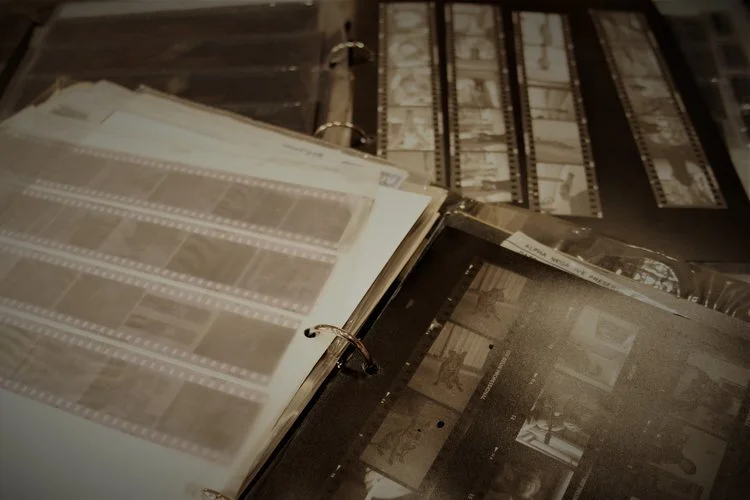Founder and Director of ARTIS PURA, Erin Salguero's first love was photography, a journey that led her to framing...
Along the way, she learned a lot not only about how to line up and shoot a great image, but the techniques and processes of old. In these digital days, we may have lost touch with the darkrooms, the chemicals and surfaces on which photographs were once printed and the impact photography has had on how we see and understand the world.
35mm Film and contact sheets from 1997. These images were taken and processed by Erin during study at Tafe.
Painters used the first, simple form of ‘photography’ or rather the act of capturing the light cast from reality, with a device called the Camera Obscura. This projected an image of what was in front of it onto a flat, glass surface, which painters then traced or copied.
Little did these clever artists know that soon enough, those images would be made permanent and do them out of a job. Painting itself was forced to change once the photograph became the established way of capturing reality…leading to the freeing up of artists and to the outpouring of creativity by painters such as Monet and Matisse, the surrealists, the modernists, the abstract expressionists and all the ‘ists’ that followed in trying to see beyond what the eye and the lens can capture.
* more on the relationship between painting and photography:
An Example of a Daguerreotype
Louis Daguerre created the first commercially viable process in the early 1800’s and it quickly it became the trend to have and carry a small Daguerreotype image of your loved ones. These were expensive, precious one-off items, made by exposing a chemically treated sheet of silver coated copper to light, and then chemically ‘fixing’ the image and removing the light sensitive component. Extremely delicate, these tiny portraits were usually placed behind glass and then in tiny decorative framed cases, to protect them. You can still find Daguerreotypes and the delicate images for sale in antique shops now and then. It’s important that you never try to open the case or remove the glass. If you need one conserved, whip it around to ARTIS PURA and they’ll take expert care of it for you. *
Soon after Daguerre’s invention, other processes followed, in an attempt to make photography more accessible and affordable. Images were made on glass (Ambrotypes) and small sheets of iron (Tintypes) and eventually, paper.
Private camera collection. Photography by Cassandra Lehman
Henry Fox-Talbot is the man given the honorable title of the inventor of modern photography, with his invention of the paper negative. The Albumen print was the first commonly produced process to make prints using a negative on paper and allowing for multiple reproductions. The name comes from the use of egg white; the albumen was the binder, which adhered the light sensitive chemicals to the paper.
Eggs weren’t the only foodstuffs used in making photographic images, the Casein is a colloid derived from milk, casein prints are soft and watercolour-like and the relatively simple process is a specialised technique still used by some artists today. All of these processes still relied on the use of light sensitised silver, just like the original Daguerreotypes.
Although the first colour photograph was made as early as 1861, colour photography wasn’t commercially available until the Kodak Company brought out Kodachrome slide film in the 1930’s. Even then, prints were not available. Prior to this, colour was usually added to photographs by hand, using thin layers of oil paint.
(Erin spent some time learning how to hand colour photographs in this traditional way and can restore old hand coloured prints as well as create a coloured version of an old black and white.See images below of a highly damaged photo with large sections missing.)
Colour negative film became wildly popular and readily available and affordable in the 1970’s. Unfortunately, many of these images are subject to fading. If you have some precious prints, we highly recommend that you check them regularly, preserve them in frames with UV glass and have copies made, as it is inevitable that they will fade over time and eventually disappear. Oddly enough, although this is a modern process, the images themselves are not likely to last anywhere as long as the beautiful and haunting black and white images of long ago. This is because colour prints don’t have any precious silver in the emulsion.
Of course, we now have digital photography, digital prints and a plethora of imagery on screens, billboards and even our phones. It serves to wonder what future generations will have to ponder on, when they think of us. Will there be any permanent archive? Although we do take and share images of every precious moment in our lives, its important to engage the services of a professional photographer every now and then, to invest in archival prints and good framing, to ensure your memories and legacy will remain for generations to come.
Author - Cassandra Lehman
ARTIS PURA are excited to have Cassandra as a permanent guest blogger. Her experience and knowledge helps to bring a broader more interesting flare to the ARTIS PURA blog
Her previous engagements include: Galleries Co-Ordinator for QCA, Griffith University, Director, Woolloongabba Art Gallery and Senior Consultant - Arts & Events to the Alice Springs Town Council where she authored the Public Art Policy. Cassandra is now working in the private sector as an independent consultant for the visual arts and culture. www.art-consultant.com.au
* ARTIS PURA can assist with conserving the piece through framing only. Although we can assist with restoration of photographic images on paper we are unable to assist on works on tin, glass etc such as Daguerreotypes and Tin types. This is a highly specialised field. If you have a piece that needs attention please pop in and we will advise if we can assist.







